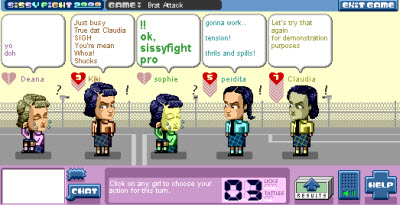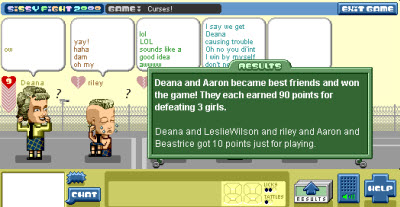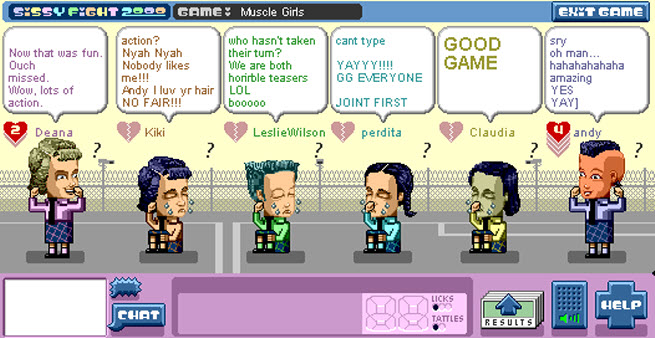Back in the year 1999, a trio of game designers created a title called Sissyfight 2000. It was a turn-based strategy game that reproduced the antics of “sissyfighting” by girls on a school playground. Now three members of the original team are launching a Kickstarter project to fund an online remake, which they will then post as an open-source title.
 At the same time, they hope to create a conversation around the game’s evidently “sexist” characterizations of girl fighting. Sissyfight 2000 was groundbreaking as a social game when it was created by a team of Word.com online magazine staff. The question is whether today’s Internet community is ready to understand the message behind Sissyfight and whether it’s sexist or not.
At the same time, they hope to create a conversation around the game’s evidently “sexist” characterizations of girl fighting. Sissyfight 2000 was groundbreaking as a social game when it was created by a team of Word.com online magazine staff. The question is whether today’s Internet community is ready to understand the message behind Sissyfight and whether it’s sexist or not.
The original team included Eric Zimmerman, Marisa Bowe, Ranjit Bhatnagar, Yoshi Sodeoka, Jason Mohr, and Naomi Clark. Zimmerman, Bhatnagar, and Clark are reuniting to create the Kickstarter, which aims to raise $20,000. The art work of Henry Darger and Edward Gorey inspired the project’s visual style.
The team plans to bring back the game with indie game site Venus Patrol, which will have a new arcade section. The original Sissyfight 2000 went offline years ago. Instead of developing a sequel, the team decided to bring the original multiplayer game back for everyone to play online. It will be available for free and open source, so anyone can create their own version of Sissyfight.
I participated in a playtest of the game, and it was spectacularly fun. The player tries to dominate the playground in a duel with five others. Each becomes a bratty little girl who has to deal with bullies, tattle-tales, and shifting friend allegiances. It sheds light “on a different kind of schoolyard violence — the emotion and social violence of the Mean Girls variety.” The original game was built in Adobe’s Shockwave and was pretty plain in its animation.
The goal of the game is to reduce the self-esteem points (the little hearts) of your opponents. When one or two girls are left, they win. With each turn, every player picks a single action without knowing what move everyone else has selected. You can “scratch” another player for one point of damage. You can “tease,” which is twice as effective as a scratch, as long as two or more girls tease the same target. A “grab” does no damage but interrupts your target’s action. A “tattle” is a powerful attack that does three damage points to everyone, but if two players tattle at the same time, then only the tattlers get in trouble. You can only tattle twice in a game. You can “lick your lolly” and get two self-esteem points back. But you can only do that three times per match. Lastly, you can “cower,” which defends you from grabs and scratches.
I actually won three matches and lost a couple as well. I found that my fellow players were quite aggressive, so I let them slug it out while I cowered or stepped back from the action. Then, when they had expended their efforts, I stepped in with a powerful “tease” attack. I found that I could take my rivals off-guard. But the same strategy never worked twice, and players could overtly collude with each other through the chat system. They could also launch verbal feints by doing the opposite of what they said they were going to do.
 In many ways, Sissyfight was ahead of its time, a social game before social-networking games became popular. Chatting with other players is an important part of the strategy. In fact, Sissyfight has been used to teach game design students for nearly a decade in college courses, workshops, and the Game Developers Workshop. Zimmerman, one of the original designers, has been an active member of the indie game development community, and he later became the founder of Gamelab, the company that developed the hit title Diner Dash (for PlayFirst).
In many ways, Sissyfight was ahead of its time, a social game before social-networking games became popular. Chatting with other players is an important part of the strategy. In fact, Sissyfight has been used to teach game design students for nearly a decade in college courses, workshops, and the Game Developers Workshop. Zimmerman, one of the original designers, has been an active member of the indie game development community, and he later became the founder of Gamelab, the company that developed the hit title Diner Dash (for PlayFirst).
All of your team members are potential enemies or allies.
The developer plans to use the Kickstarter money to recode the game to make it playable under today’s browsers. Bhatnagar, the original programmer, will head the recoding effort. He is now a media artist who exhibits around the world. His sound sculpture will be exhibited this year at the Palais de Tokyo Museum in Paris and at the Tinguely Museum in Basel. Clark, based in New York, has worked on games with companies like Lego, Gamelab, and Fresh Planet. Zimmerman is on the faculty at the NYU Game Center and is an independent game designer.
Now, the intentional sexism of the game bothered me. I felt like I would never show this game to my daughters, who probably wouldn’t understand the intentional irony in the sexism. If a game looks sexist and plays sexist, then it must be sexist, right? I complained to Zimmerman that the game hadn’t kept up with the times and that it was wrong not to have boys fighting like sissies, as they are perfectly capable of doing so on the playground.
Zimmerman replied, “This is a great question. In fact, Sissyfight [which he spells SiSSYFiGHT] has an intentional gender imbalance. It is a conscious intervention into the culture of games — at least it was in the late 90s, and it still feels like an interesting statement today. Sissyfight is very much a feminist video game — in that it consciously grapples with ideas around the social construction of gender. I wrote about some of this in Rules of Play — how Sissyfight creates a kind of female identity which is neither princess-to-be-rescued nor action-hero-in-tight-shorts.”
In the FAQ for the game, the team acknowledges that a game where the goal is to “bully and humiliate other girls” seems a little wrong. It is intended for adults to reflect back on “adolescent struggles with dark humor, morbid nostalgia, and maybe a touch of vengeful revisionism.” It also depicts the aforementioned emotional violence.

